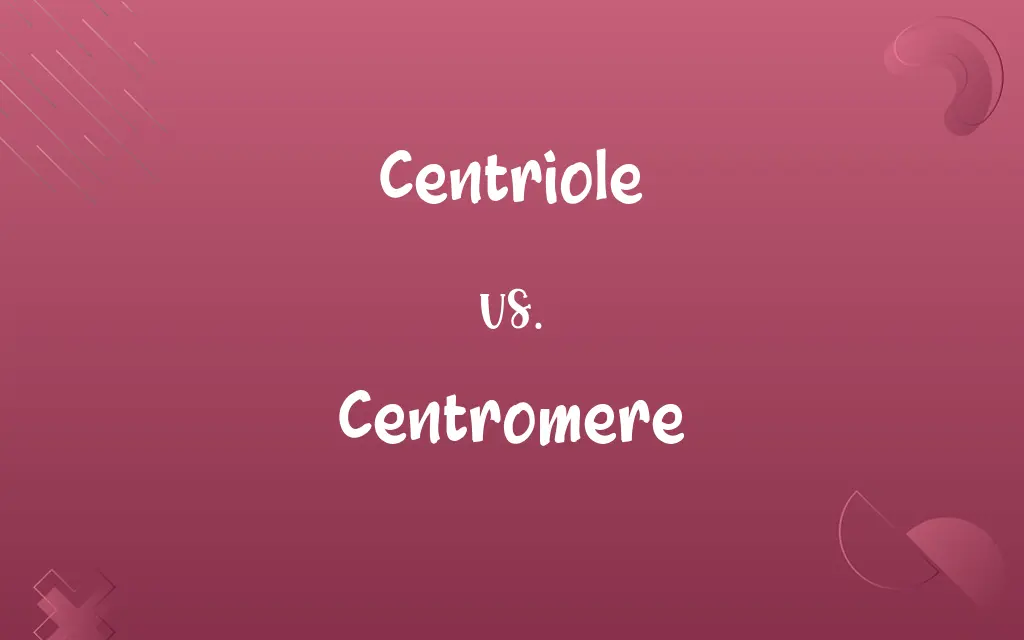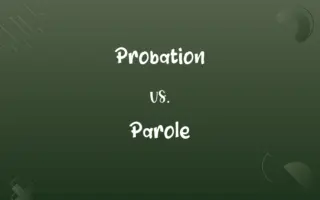Centriole vs. Centromere: Know the Difference

By Shumaila Saeed || Published on January 13, 2024
Centrioles are cylindrical cell structures involved in cell division and cilia formation, while centromeres are specific DNA sequences where chromatids are held together during cell division.

Key Differences
Centrioles are cylindrical structures, typically found in pairs, and composed mainly of a protein called tubulin. They are located near the nucleus in animal cells. Centromeres, in contrast, are specific regions of DNA, located on chromosomes, where sister chromatids are most tightly connected.
Shumaila Saeed
Jan 13, 2024
During cell division, centrioles play a crucial role in the formation of the spindle fibers that separate chromosomes. Centromeres, on the other hand, serve as attachment points for spindle fibers and are essential for the equal distribution of chromosomes to daughter cells.
Shumaila Saeed
Jan 13, 2024
Centrioles are self-replicating structures, duplicating during the S phase of the cell cycle. Centromeres do not replicate independently; they are part of the chromosome and are duplicated as a part of DNA replication.
Shumaila Saeed
Jan 13, 2024
Centrioles are also involved in forming cilia and flagella in certain cells, contributing to cell movement. Centromeres have no direct role in non-dividing cells, but they maintain chromosome integrity.
Shumaila Saeed
Jan 13, 2024
Centrioles are composed of microtubules arranged in a specific pattern. Centromeres, however, contain specific DNA sequences that can vary significantly in length and sequence between different organisms.
Shumaila Saeed
Jan 13, 2024
ADVERTISEMENT
Comparison Chart
Structure
Cylindrical, composed of microtubules
DNA region, specific sequence
Shumaila Saeed
Jan 13, 2024
Role in Cell Division
Forms spindle fibers
Attachment point for spindle fibers
Shumaila Saeed
Jan 13, 2024
Replication and Formation
Self-replicating during S phase
Part of chromosome, replicated with DNA
Shumaila Saeed
Jan 13, 2024
ADVERTISEMENT
Centriole and Centromere Definitions
Centriole
A centriole is a small, cylindrical cell structure made of microtubules.
In the cell, the centriole helps organize the assembly of microtubules.
Shumaila Saeed
Dec 28, 2023
Centromere
Centromeres are DNA sequences serving as spindle attachment points.
Spindle fibers attached at the centromere to segregate chromosomes.
Shumaila Saeed
Dec 28, 2023
Centriole
Centrioles are primarily observed in animal cells.
The biologist noted the presence of centrioles in the animal cell sample.
Shumaila Saeed
Dec 28, 2023
Centromere
The centromere is integral in ensuring equal chromosome distribution during cell division.
Abnormalities in the centromere can lead to chromosomal disorders.
Shumaila Saeed
Dec 28, 2023
Centriole
Centrioles are involved in the formation of spindle fibers during cell division.
The centriole migrated to opposite poles to aid in mitosis.
Shumaila Saeed
Dec 28, 2023
ADVERTISEMENT
Centromere
Centromeres vary in size and sequence across different species.
The geneticist studied the centromere sequences in various organisms.
Shumaila Saeed
Dec 28, 2023
Centriole
In certain cells, centrioles form the basis of cilia and flagella.
The centriole evolved into a basal body to give rise to cilia.
Shumaila Saeed
Dec 28, 2023
Centromere
Centromeres are a key feature in the structural organization of chromosomes.
The centromere's position determines the chromosome's shape during metaphase.
Shumaila Saeed
Dec 28, 2023
Centriole
Centrioles are self-replicating structures found near the cell nucleus.
Each centriole in the cell was duplicated before cell division.
Shumaila Saeed
Dec 28, 2023
Centromere
A centromere is a region on a chromosome that joins sister chromatids.
The centromere's position is crucial for the chromosomes' alignment during mitosis.
Shumaila Saeed
Dec 28, 2023
Centriole
One of two cylindrical cellular structures that are composed of nine triplet microtubules and form the asters during mitosis.
Shumaila Saeed
Dec 27, 2023
Centromere
The most condensed and constricted region of a chromosome, to which the spindle fiber is attached during mitosis.
Shumaila Saeed
Dec 27, 2023
Centriole
(biology) A barrel-shaped microtubule structure found in most animal cells, important in the process of mitosis (nuclear division).
Shumaila Saeed
Dec 27, 2023
Centromere
(genetics) The central region of a eukaryotic chromosome where the kinetochore is assembled.
Shumaila Saeed
Dec 27, 2023
Centriole
One of two small cylindrical cell organelles composes of nine triplet microtubules, which form the asters during mitosis.
Shumaila Saeed
Dec 27, 2023
Centromere
A specialized condensed region of a chromosomes that appears during mitosis where the chromatids are held together to form an X shape.
Shumaila Saeed
Dec 27, 2023
Centriole
One of two small cylindrical cell organelles composes of 9 triplet microtubules; form the asters during mitosis
Shumaila Saeed
Dec 27, 2023
Centromere
A specialized condensed region of each chromosome that appears during mitosis where the chromatids are held together to form an X shape;
The centromere is difficult to sequence
Shumaila Saeed
Dec 27, 2023
Repeatedly Asked Queries
Are centromeres part of the DNA?
Yes, they are specific DNA sequences on chromosomes.
Shumaila Saeed
Jan 13, 2024
What does a centromere do?
It holds sister chromatids together and attaches them to spindle fibers.
Shumaila Saeed
Jan 13, 2024
How many centrioles are in a cell?
Typically, a cell has a pair of centrioles.
Shumaila Saeed
Jan 13, 2024
What is a centriole?
A cylindrical structure in cells, involved in cell division and forming cilia.
Shumaila Saeed
Jan 13, 2024
What is the composition of centrioles?
Centrioles are composed of microtubules.
Shumaila Saeed
Jan 13, 2024
What happens if a centromere is damaged?
It can lead to improper chromosome separation, causing genetic disorders.
Shumaila Saeed
Jan 13, 2024
Is the centromere a permanent structure?
It's a permanent part of the chromosome, present throughout the cell cycle.
Shumaila Saeed
Jan 13, 2024
How does the centromere contribute to genetic stability?
By ensuring accurate chromosome segregation during cell division.
Shumaila Saeed
Jan 13, 2024
Are centrioles visible under a microscope?
Yes, with a high-power microscope.
Shumaila Saeed
Jan 13, 2024
Can centromere position vary?
Yes, centromere position can vary, affecting chromosome shape.
Shumaila Saeed
Jan 13, 2024
Do centromeres have a role in genetic inheritance?
Indirectly, by ensuring proper chromosome distribution.
Shumaila Saeed
Jan 13, 2024
How do centromeres affect cell division?
They are crucial for the equal distribution of genetic material.
Shumaila Saeed
Jan 13, 2024
Do centromeres change over evolutionary time?
Yes, centromere DNA can evolve, affecting chromosome function.
Shumaila Saeed
Jan 13, 2024
Do centrioles have a role in non-dividing cells?
They are involved in forming cilia and flagella.
Shumaila Saeed
Jan 13, 2024
Can centrioles be found in all animal cells?
Most animal cells have them, but not all.
Shumaila Saeed
Jan 13, 2024
Are centrioles involved in human diseases?
Abnormalities in centriole function can contribute to diseases like cancer.
Shumaila Saeed
Jan 13, 2024
Are centromeres unique to eukaryotes?
Yes, they are specific to eukaryotic chromosomes.
Shumaila Saeed
Jan 13, 2024
Share this page
Link for your blog / website
HTML
Link to share via messenger
About Author
Written by
Shumaila SaeedShumaila Saeed, an expert content creator with 6 years of experience, specializes in distilling complex topics into easily digestible comparisons, shining a light on the nuances that both inform and educate readers with clarity and accuracy.









































































